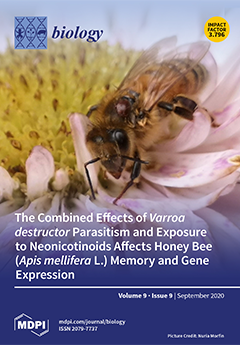For this study, we measured the concentrations of 23 trace elements (Al, As, Ba, Bi, Cd, Cr, Co, Cu, Fe, Ga, Hg, In, Li, Mn, Mo, Ni, Pb, Se, Sr, Ti, Tl, V, and Zn) in the whole bodies of three functional feeding
[...] Read more.
For this study, we measured the concentrations of 23 trace elements (Al, As, Ba, Bi, Cd, Cr, Co, Cu, Fe, Ga, Hg, In, Li, Mn, Mo, Ni, Pb, Se, Sr, Ti, Tl, V, and Zn) in the whole bodies of three functional feeding groups (FFG) (filterers—Hydropsychidae, scrapers—Heptageniidae, and predators—Odonata) of aquatic insects collected from two sites in the Po basin (Po Settimo and Malone Front, Northwest Italy) to determine: (a) how FFG influence trace element accumulations, (b) if scrapers accumulate higher elements compared to the other FFG, since they graze on periphyton, which represents one of the major sinks of metals, and (c) the potential use of macroinvertebrates to assess the bioavailability of trace elements in freshwater. The hierarchical clustering analysis generated three main groups based on trace element concentrations: the most abundant elements were Fe and Al, followed by Sr, In, Zn, V, Mo, and Cu. Tl was below the limit of detection (LOD) in all FFG. Ga was detected only in scrapers from both sites and Hg only in predators from Po Settimo. The principal component analysis showed that concentrations of Al, As, Bi, Cd, Co, Cr, Ga, Fe, In, Mn, Pb, Ni, and Sr were highest in scrapers, suggesting that trace elements accumulate from the ingestion of epilithic periphyton (biofilm). Odonata (predators) accumulate certain elements (Ba, Hg, Li, Se, V, Ti, and Zn) in higher concentrations by food ingestion composed of different aquatic organisms. Differently, Cu and Mo concentrations were the highest in filterers due to their bioavailability in the water column. Non-metric multidimensional scaling clearly differentiated the FFG based on their ability to accumulate trace elements. The findings from this study represent an important step toward the definition of an innovative approach based on trace element accumulation by macroinvertebrates.
Full article






